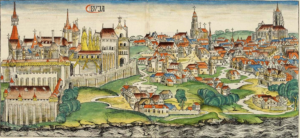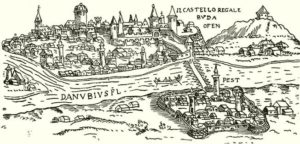Buda

Buda castle before the Ottoman occupation
The castle of Buda was built after 1243 on the “Pesti Újhegy” (New Hill of Pest) which is now actually the hill of Buda castle. The constructions were intensified in 1246 when a second Mongolian invasion was expected. According to a document of King IV.Béla, the castle was ready in 1255. In fact, the second Mongolian invasion took place in 1285 when the Tatars besieged Buda castle but they could not take it. It is not generally known that this second attack of the Mongols was quite easily repelled by the Hungarians.

The burghers of Buda were not always on good terms with the Church. We know that they could expel the high priests from Buda in 1279 with the help of King László IV. Ten years later, Cardinal Lodomér of Esztergom excommunicated the inhabitants of the city along with Comes Walter, the leader of the burghers of Buda.
After the end of the Árpád dynasty, King Károly Róbert’s army, led by Comes István, son of Márk from the Csák Clan tried to take Buda by siege in 1302, but it was in vain. Buda was staunchly defended by those noblemen and burghers who were supporting King Vencel (Waclaw) who used to rule Hungary between 1301 and 1305. This time, it was Pope Bonifác VIII. who excommunicated King Vencel and the burghers of Buda.
It is without example in history, that the burghers of Buda excommunicated the Pope in return. At last, King Vencel left the country in 1304 but the Pope got angry and qualified Buda as a heretic town in 1307. It was the year when the followers of Károly Róbert in Buda could take over the rule and cede it to the new king.

The next army at Buda’s walls was the army of the oligarch Csák Máté in 1311 who could not take it, either. The Anjou kings built beautiful palaces on the southern part of the castle hill in the 1330s. King Nagy Lajos (Louis the Great) decided to remove the royal seat from Visegrád to Buda in 1354. After this, the steady growth of the town was guaranteed. It was King Zsigmond who built the so-called “Fresh Palace” (or new palace) between 1410 and 1430. (It was the palace that was utterly destroyed in the gunpowder blasts of 1578 and 1686.) The rest of the buildings (throne hall, royal quarters, observatory, library) were finished in Renaissance style by King Matthias Corvinus. The southern Great Round Bastion was built at that time, too.

There was a revolt in Buda in May 1525 between the German and the Hungarian burghers of the town. King Louis II appointed Bornemissza János as his castellan before the Battle of Mohács.
Buda during the Ottoman occupation
The city was first pillaged by Sultan Suleiman in 1526, right after the Battle of Mohács. When he left for home, he took away the Jewish burghers to his empire because they were afraid of the Christians’ revenge. For the time being, King Szapolyai took Buda but it was taken by King Ferdinand in 1527. In fact, during the Dual Kingship, the Habsburg ruler tried to take Buda ten times between 1526 and 1541. King Szapolyai regained the town with the Turks’ help in 1529.

General Roggendorf was trying to take it by a siege in 1530 but it was in vain. Then, King Szapolyai had the defenses rebuilt with the help of the Italian engineer Domenico da Bologna. When the king died, Habsburg Ferdinand sent his troops against Buda but the Hungarians defended it valiantly until the Ottoman reinforcing army arrived, led by Sultan Suleiman. He took the castle by a trick and placed his garrison in it on 29 August 1541. Then the Turks robbed the European famous library of King Matthias and systematically destroyed the frescoes and sculptures of the most beautiful gothic cathedral in the center. It was the time when the Jewish inhabitants were allowed to return from the Ottoman Empire to Buda, after two decades.

The Christians tried to retake it in 1542 but they were defeated. Later, Buda became the most important western frontier castle of the Ottoman Empire. The Pasha or Begler Bey of Buda had been the second-highest ranked person after the Sultan, usually after the Grand Vizier. He was in charge of the Vilayet of Buda, and he was the first military commander and the first leader in the civil administration at the same time. Besides, he was authorized to conduct diplomatic negotiations with the Habsburg powers. In the absence of the Sultan or the Grand Vizier, the Pasha of Buda was the leader of the entire Turkish army in Occupied Hungary.

All the other Vilayets belonged under his rule. The Pasha of Buda automatically received the rank of a Vizier from 1623 on. The Ottomans were carefully building out a strong belt of castles around Buda (like Esztergom or Székesfehérvár) and established a chain of forts towards Vienna. In peaceful times, the garrison of Buda numbered two thousand soldiers, mostly Janissaries.

There was a traveler who worked for the Fuggers, Hans Dernschwam, who described the poor conditions in 1555. He wrote of it as:
“The houses are collapsing one by one. There is no trace of new construction, except some shads where one could take shelter from rain and snow. There had been great halls and stalls that now are divided into hundreds of makeshift cells made of stone, wood, and clay.” (…) “The Turks don’t need wine cellars so they had filled them with garbage. The houses look as if they had no owner…they made a mosque from the Catholic church and threw the altar and the tombstones out . . . many rooms are walled in. The houses look like pigsties and they are so much built around that you couldn’t recognize the wagon-entrances because they fabricated stalls and a bazaar in front of the houses where the Turkish craftsmen sit and work according to their habits.”

The Christians tried to retake Buda in 1566 but it was an unsuccessful attempt. It is an interesting fact, that before the fall of Szigetvár castle in 1566, the Turks had not been holding Buda so safely in their hands: when they traveled there, they could approach their own town only if they had a small army guarding them on the way there. Roads to Buda got safer only after 1566.

The explosion on 19 May 1578

During the 15-Year-War, the army of Pálffy Miklós, Adolf Schwarzenberg, and Nádasdy Tamás besieged the castle in 1598 but could not take it. General Russwurm was also unsuccessful in 1602 and 1603. Later, the Christians attacked it in 1684 but they were repelled after 104 days. Finally, Buda was taken by a hard siege in 1686 when the combined Imperial troops, led by Prince Charles of Lothar and Prince Maximilian Emanuel, with the participation of many Hungarians as well. During the siege, the original palace of King Matthias was utterly destroyed by an explosion. You can read more about the heroes here:
https://www.hungarianottomanwars.com/essays/a-hero-of-buda-who-was-almost-hanged/

The local Jewish population was always fighting on the Ottoman side to defend their privileges, and they were fighting to the end in 1686 as well. Unfortunately, it led to a serious pogrom when Buda was liberated. Not only the Jews but almost everybody else was massacred. After the siege, the rebuilding began at once and the German-speaking population was settled in the city. You can read more about the liberation of Buda Castle here:
https://www.hungarianottomanwars.com/1541-1699/2-september-1686-buda-eliberata/
The siege of Buda was a particularly fierce fight in 1849 when the Hungarians took it back from the Habsburgs. The castle also suffered great damage during WWII. Look at a video of the castle: you can see pictures of what it had looked like before 1945:
https://www.youtube.com/watch?v=ZajWqdmrMyI

Unfortunately, they had pulled down several beautiful parts in the 1950s and 1960s which could have been saved. Now, the castle is being renovated again.

Dear Readers, I can only make this content available through small donations or by selling my books or T-shirts:
Please, feel free to support me with a coffee here:
You can check out my books on Amazon or Draft2Digital, they are available in hardcover, paperback, or ebook:
https://www.amazon.com/dp/198020490X or at https://books2read.com/b/boYd81

My work can also be followed and supported on Patreon: Become a Patron!http://Become a Patron!

[wpedon id=”9140″]

https://hungarianottomanwars.myspreadshop.com/all






































